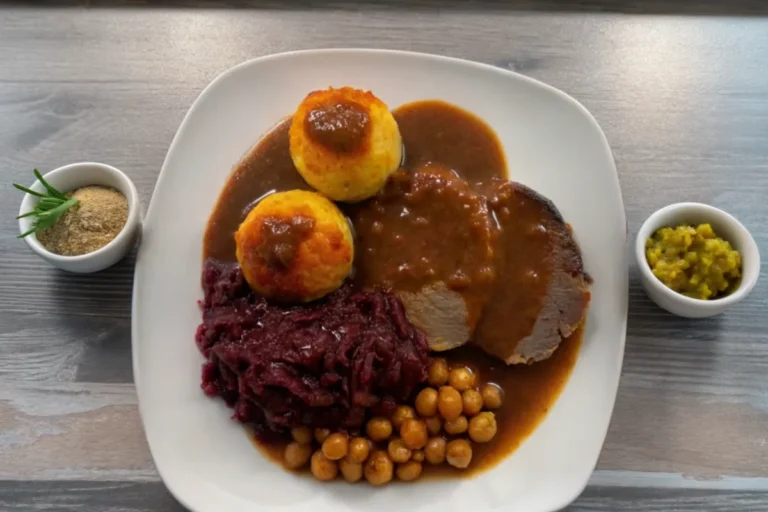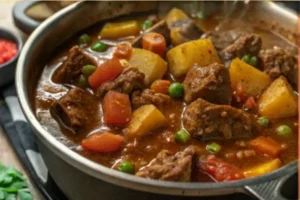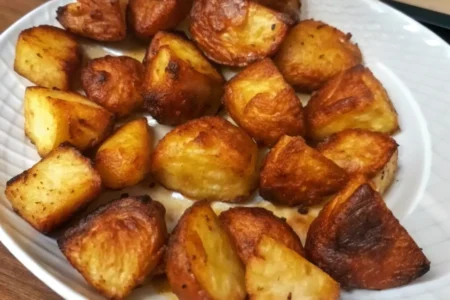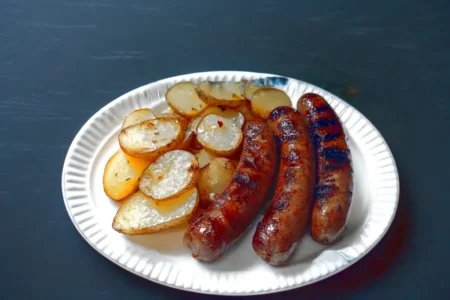I’ll never forget the first time I opened my grandmother’s fridge and found a giant slab of beef floating in what looked like a science experiment—chunks of onion, strange herbs, and a dark, vinegar-y liquid. “It’s for the sauerbraten,” she said, like it was the most obvious thing in the world. At the time, I couldn’t understand why anyone would soak meat for days on purpose. Now? It’s one of my favorite traditions.
If you’ve never tried sauerbraten, Germany’s beloved pot roast, buckle up. It’s not just dinner—it’s an event. The magic lies in its tangy marinade, a slow braise, and the thick, cookie-sweetened gravy. Oh, and don’t get me started on the dumplings.
Let’s dive into why this dish has been passed down for centuries, why it’s still worth making, and how to pull it off in your own kitchen—even if you don’t have a German grandma whispering over your shoulder.
What Exactly Is Sauerbraten?
Sauerbraten translates to “sour roast.” And yes, it earns that name. Traditionally made with a tougher, lean cut of beef like bottom round or rump roast, the meat gets bathed in a vinegar-heavy marinade for days—sometimes up to a week. The acid slowly breaks down the fibers, turning tough into tender.
The result? A roast that’s got a subtle tang all the way through, smothered in a rich, sweet-sour gravy thickened with crushed ginger snaps (yep, cookies in your sauce). Served with soft potato dumplings or spätzle, it’s the kind of dish that sticks to your ribs—and your memory.
A German cousin once joked, “The longer it marinates, the closer it tastes to our ancestors.” Not sure if that’s a compliment or a warning.
A Short (and Tasty) History
Legend has it that sauerbraten dates back to the Romans, who preserved meats in wine during their journeys north into what’s now Germany. Some say Charlemagne had a hand in popularizing it. Others credit the food-loving Cologne region.
Whatever its origins, the dish became a German staple, varying slightly by region. In southern Germany, they add lebkuchen (spiced Christmas cookies) to the gravy. In the Rhineland, they’re more generous with raisins. Over in Bavaria, red wine dominates the marinade. Each area brings its own flair—kind of like every family’s meatloaf recipe.
Why the Long Marinade?
You might wonder: Why not just cook the beef and pour vinegar on top? Well, soaking the meat for days lets the acid slowly seep in, flavoring and tenderizing from the inside out. It’s not just a flavor bomb—it’s food science.
One food blogger I follow joked, “If your fridge doesn’t smell like vinegar by day three, are you even making sauerbraten?” Fair point.
In today’s fast-paced kitchens, it’s rare to plan a meal a week ahead. But that’s what makes this dish feel special. It forces you to slow down, to anticipate. And when you finally pull that roast from the oven, it feels earned.
Let’s Talk Ingredients
What I love about sauerbraten is how flexible it can be. Sure, there are purists who’ll insist you need juniper berries, or exactly one part vinegar to four parts liquid, but honestly? This dish forgives substitutions.
Here’s what you’ll need for a classic version:
| Ingredient | Substitute Ideas |
|---|---|
| 2.5 lb bottom round | Any lean, tough roast |
| Red wine vinegar | Apple cider vinegar, sherry |
| Red wine (boxed fine) | Any leftover table wine |
| Onions | Shallots, leeks, or both |
| Carrots, celery | Optional—use any aromatics |
| Juniper berries | Skip if you can’t find them |
| Bay leaves, cloves | Optional but recommended |
| Ginger snaps | Any spiced cookie substitute |
One quirk I learned? Never marinate in bare metal. The acid reacts and can give off a metallic taste (and worse, leach metals). Always use glass, ceramic, or enameled cast iron.
The Process, Step by Step
1. Marinate the Beef
Simmer the vinegar, wine, onions, carrots, celery, garlic, herbs, and spices for a few minutes to mellow the sharpness. Cool it down (ice cubes work wonders). Pour it over the raw roast in a non-metallic container. Make sure it’s submerged. Let it chill in the fridge for 4-7 days, flipping occasionally.
💡 Tip: If you can smell it every time you open the fridge, you’re doing it right.
2. Brown That Beauty
Pat the roast dry after marinating. Brown it well in a little oil on all sides, paying attention to any fat cap. This step adds flavor and seals in juices.
Funny story: The first time I tried this, I left the burner too high. My kitchen smelled like a medieval tavern. Lesson learned—watch the heat!
3. Braise and Wait
Place the roast back into the marinade. Deglaze your browning pan with a bit of water and pour those tasty bits into the pot. Some cooks add a roux (flour or potato starch browned in fat) to help thicken later.
Cover and cook low and slow—either on the stovetop or in a 300°F oven for 3-4 hours—until fork-tender.
4. Make the Dumplings
Meanwhile, bake a few potatoes until soft. Scoop out the flesh, season, add an egg, and stir in flour or potato starch until it forms a soft dough. Roll into golf balls and boil in salted water until they float (about 10 minutes). Toss with butter.
If you’ve ever made gnocchi, you’re halfway there. Just don’t overmix—the key is keeping them light, not rubbery.
5. The Cookie Secret
Once the roast is done, remove it. Bring the cooking liquid to a boil and strain out the solids. Then comes the fun part: stir in crushed ginger snaps to thicken the gravy. Yep, cookies. A handful at a time, until it’s as thick as you like.
If this sounds weird, trust me—it’s brilliant. The spices from the cookies meld with the vinegar and wine, balancing sour with warm sweetness. It’s like alchemy in a pot.
Serving Up a Hearty Plate
Slice the roast thin (it might look a little dry inside—don’t panic). Smother each slice with gravy. Add a few dumplings on the side, and spoon extra gravy over everything. Sprinkle chopped parsley on top if you’re feeling fancy.
One German friend once told me, “Nobody eats sauerbraten dry. It’s just a sauce delivery system.” Honestly, she’s right.
5 Ways to Serve Sauerbraten Leftovers
If you’re lucky enough to have leftovers (or smart enough to plan for them), here are some tasty ideas:
- Sauerbraten sandwiches on crusty rolls
- Tossed into pasta with gravy as a sauce
- Chopped into a hearty stew with veggies
- Folded into pierogi or dumplings
- Layered on rye bread with sauerkraut and mustard
Pro tip: The gravy thickens beautifully overnight and makes an amazing base for soups or sauces.
Cultural Tidbits & Fun Facts
✅ In Cologne, sauerbraten is often made with horse meat (though beef is more common today). Don’t worry—no horses were harmed in my kitchen.
✅ In some German regions, people swear by adding raisins or apple slices to the gravy for extra sweetness.
✅ Traditionally served at weddings and festivals, it was once considered a celebratory dish reserved for special occasions.
✅ The longer it marinates, the softer (and more sour) it gets. Some folks swear by a 10-day soak!
A Dish That Brings People Together
Every time I make sauerbraten, it feels like I’m keeping a little culinary history alive. Sure, it takes patience. Yes, it perfumes your fridge for a week. And no, it’s not “fast food” by any stretch. But when you spoon that gravy over tender beef and fluffy dumplings? Suddenly, the waiting makes sense.
Food like this teaches you to slow down, to gather, to savor. In a world where everything’s instant, sauerbraten reminds us that some flavors—and some moments—can’t be rushed.
Would I make it every week? Probably not. But once a year, when the leaves turn and the air chills? Absolutely.
So next time you’ve got a bottom round roast and a few days to spare, give this German classic a try. Just don’t forget the ginger snaps.
Because in the words of a wise old cook I once met: “Without the cookies, it’s just sour beef.”
Print
Sweet, Sour, and Oh-So German: Making Sauerbraten with Dumplings
A classic German pot roast marinated in vinegar and spices, slow-braised until tender, and served with pillowy potato dumplings and a rich, sweet-sour gravy thickened with ginger snaps.
- Total Time: 4 hours 30 minutes
- Yield: Serves 4–6 1x
Ingredients
For the marinade and roast:
-
2.5 lb (1.1 kg) bottom round beef roast
-
2 small onions, chopped
-
2 carrots, chopped
-
2 celery stalks, chopped
-
3 garlic cloves, smashed
-
1 stick rosemary (optional)
-
4–5 juniper berries (optional)
-
2 bay leaves
-
2 cloves
-
1 cup red wine vinegar
-
2 cups red wine
-
2 cups water (as needed)
-
Salt and pepper to taste
For the gravy:
-
8–10 ginger snap cookies, crushed
-
1 tbsp potato starch or flour (optional, for roux)
For the dumplings:
-
2 large baking potatoes
-
1 egg
-
1/4 cup potato starch or flour
-
Salt, garlic powder, onion powder to taste
-
2 tbsp butter
Instructions
Step 1: Make the marinade
In a large pot, combine vinegar, wine, onions, carrots, celery, garlic, rosemary, juniper berries, bay leaves, and cloves. Bring to a brief boil to mellow sharpness. Cool completely.
Step 2: Marinate the beef
Place roast in a non-metal container. Pour marinade over to submerge. Cover and refrigerate 4–7 days, turning occasionally.
Step 3: Brown the roast
Remove roast, pat dry. Brown on all sides in a hot pan with oil. Deglaze pan with a splash of water and pour drippings back into the marinade.
Step 4: Braise
Return roast to marinade. Cover and cook in a 300°F (150°C) oven for 3–4 hours, until fork-tender.
Step 5: Make the dumplings
Bake potatoes at 300°F until soft. Scoop flesh into a bowl. Season with salt, garlic powder, and onion powder. Add egg and potato starch, mixing gently into a dough. Roll into balls. Boil in salted water until they float (about 10 minutes). Toss in butter.
Step 6: Finish the gravy
Remove roast. Strain cooking liquid. Bring liquid to a boil. Stir in crushed ginger snaps gradually until desired thickness. Season with salt and pepper.
Step 7: Serve
Slice roast thinly. Serve with dumplings and lots of gravy. Garnish with chopped parsley.
Notes
-
Marinate up to 7 days for deeper flavor.
-
Swap red wine for apple cider vinegar for a milder tang.
-
Ginger snaps can be replaced with lebkuchen or speculoos cookies.
-
Dumplings can be held warm, tossed in butter, for hours.
- Prep Time: 30 minutes
- Cook Time: 4 hours
- Method: Braising
- Cuisine: German






